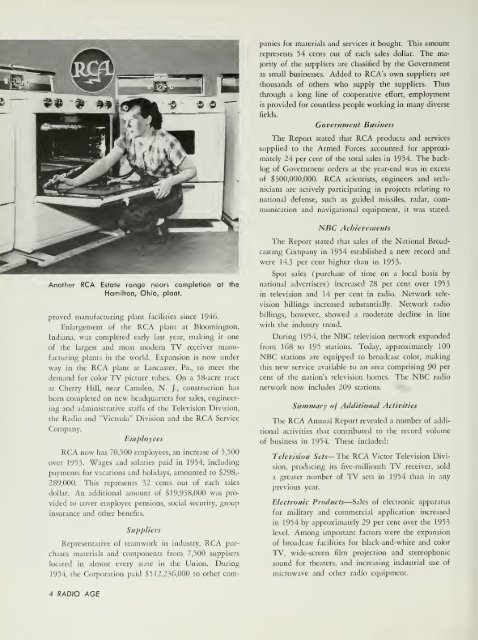Radio Age - 1955, April - 36 Pages, 2.8 MB, .PDF - VacuumTubeEra
Radio Age - 1955, April - 36 Pages, 2.8 MB, .PDF - VacuumTubeEra
Radio Age - 1955, April - 36 Pages, 2.8 MB, .PDF - VacuumTubeEra
You also want an ePaper? Increase the reach of your titles
YUMPU automatically turns print PDFs into web optimized ePapers that Google loves.
1954, the Corporation paid $512,2<strong>36</strong>,000 to other companies<br />
for materials and services it bought. This amount<br />
represents 54 cents out of each sales dollar. The majority<br />
of the suppliers are classified by the Government<br />
as small businesses. Added to RCA's own suppliers are<br />
thousands of others who supply the suppliers. Thus<br />
through a long line of cooperative effort, employment<br />
is provided for countless people working in many diverse<br />
fields.<br />
Government Business<br />
The Report stated that RCA products and services<br />
supplied to the Armed Forces accounted for approximately<br />
24 per cent of the total sales in 1954. The backlog<br />
of Government orders at the year-end was in excess<br />
of $300,000,000. RCA scientists, engineers and technicians<br />
are actively participating in projects relating to<br />
national defense, such as guided missiles, radar, communication<br />
and navigational equipment, it was stated.<br />
NBC Achievements<br />
Another RCA Estate range nears completion at the<br />
Hamilton, Ohio, plant.<br />
proved manufacturing plant facilities since 1946.<br />
Enlargement of the RCA plant at Bloomington,<br />
Indiana, was completed early last year, making it one<br />
of the largest and most modern TV receiver manufacturing<br />
plants in the world. Expansion is now under<br />
way in the RCA plant at Lancaster, Pa., to meet the<br />
demand for color TV picture tubes. On a 58-acre tract<br />
at Cherry Hill, near Camden, N. J., construction has<br />
been completed on new headquarters for sales, engineering<br />
and administrative staffs of the Television Division,<br />
the <strong>Radio</strong> and "Victrola" Division and the RCA Service<br />
Company.<br />
Employees<br />
RCA now has 70,500 employees, an increase of 5,500<br />
over 1953. Wages and salaries paid in 1954, including<br />
payments for vacations and holidays, amounted to $298,-<br />
289,000. This represents 32 cents out of each sales<br />
dollar. An additional amount of $19,938,000 was provided<br />
to cover employee pensions, social security, group<br />
insurance and other benefits.<br />
Suppliers<br />
Representative of teamwork in industry, RCA purchases<br />
materials and components from 7,500 suppliers<br />
located in almost every state in the Union. During<br />
The Report stated that sales of the National Broadcasting<br />
Company in 1954 established a new record and<br />
were 14.3 per cent higher than in 1953.<br />
Spot sales (purchase of time on a local basis by<br />
national advertisers) increased 28 per cent over 1953<br />
in television and 14 per cent in radio. Network television<br />
billings increased substantially. Network radio<br />
billings, however, showed a moderate decline in line<br />
with the industry trend.<br />
During 1954, the NBC television network expanded<br />
from 168 to 195 stations. Today, approximately 100<br />
NBC stations are equipped to broadcast color, making<br />
this new service available to an area comprising 90 per<br />
cent of the nation's television homes. The NBC radio<br />
network now includes 209 stations.<br />
Summary of Additional Activities<br />
The RCA Annual Report revealed a number of additional<br />
activities that contributed to the record volume<br />
of business in 1954. These included:<br />
Television Sets— The RCA Victor Television Division,<br />
producing its five-millionth TV receiver, sold<br />
a greater number of TV sets in 1954 than in any<br />
previous year.<br />
Electronic Products—Sales of electronic apparatus<br />
for military and commercial application increased<br />
in 1954 by approximately 29 per cent over the 1953<br />
level. Among important factors were the expansion<br />
of broadcast facilities for black-and-white and color<br />
TV, wide-screen film projection and stereophonic<br />
sound for theaters, and increasing industrial use of<br />
microwave and other radio equipment.<br />
4 RADIO AGE
















